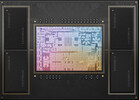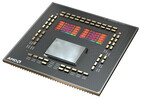Apple M2 Pro vs AMD Ryzen 9 5900X
Apple M2 Pro
► remove from comparison
The Apple M2 Pro is a System on a Chip (SoC) from Apple that is found in the early 2023 MacBook Pro 14 and 16-inch models. It offers all 12 cores available in the chip divided in eight performance cores (P-cores) and four power-efficiency cores (E-cores). The E-cores clock with up to 3.4 GHz, the P-Cores up to 3.7 GHz (mostly 3.3 GHz in multi-threaded workloads and 3.4 GHz in single threaded).
The big cores (codename Avalanche) offer 192 KB instruction cache, 128 KB data cache, and 36 MB shared L2 cache (up from 24 MB in the M1 Pro). The four efficiency cores (codename Blizzard) are a lot smaller and offer only 128 KB instruction cache, 64 KB data cache, and 4 MB shared cache. CPU and GPU can both use the 24 MB SLC (System Level Cache).
The unified memory (16 or 32 GB LPDDR5-6400) next to the chip is connected by a 256 Bit memory controller (200 GB/s bandwidth) and can be used by the GPU and CPU.
Apple states that the M2 Pro has a 25% higher performance than the M1 Pro in Xcode compiling.
The integrated graphics card in the M1 Pro offers all 19 cores.
Furthermore, the SoC integrates a fast 16 core neural engine (faster than M1 Pro), a secure enclave (e.g., for encryption), a unified memory architecture, Thunderbolt 4 controller, an ISP, and media de- and encoders (including ProRes).
The M2 Pro is manufactured in 5 nm at TSMC (second generation) and integrates 40 billion transistors.
AMD Ryzen 9 5900X
► remove from comparison
The AMD Ryzen 9 5900X is a high-end 12-core, hyperthreaded (SMT) Vermeer series desktop processor that can process 24 threads simultaneously. Introduced on October 8, 2020, the Ryzen 9 5900X is the fastest 12-core processor and is specified at 105 watts TDP. The top model, the AMD Ryzen 9 5950X, offers even more power and at the same time offers another 4 cores and 8 threads.
The Ryzen 9 5900X clocks with 3.7 GHz base clock and reaches up to 4.8 GHz on one core in turbo mode. However, when all 12 cores are loaded, up to 4.5 GHz is still possible.
The performance of the AMD Ryzen 9 5900X is consistently excellent in all applications and significantly better than the AMD Ryzen 9 3900X. AMD has been able to significantly improve its single thread performance in particular and even beats the Intel Core i9-10900K in this discipline. The multi-thread performance could also be improved. In an in-house duel, the AMD Ryzen 9 5900X can even take on an AMD Threadripper 2950X.
The internal structure of the processor has not changed fundamentally at first glance. The CCX structure has changed a bit compared to Zen2, because now a CCX consists of up to 8 CPU cores. So each individual core can access the complete L3 cache (32 MByte). Furthermore the CCX modules are connected to each other via the same I/O die, which we already know from Zen2. According to AMD, the Infinity-Fabric should now reach clock rates of up to 2 GHz, which in turn allows a RAM clock of 4.000 MHz without performance loss.
For the manufacturing processes, AMD also relies on TSCM for the Vermeer processors for the 7nm production of the CPU cores, although the I/O die is still supplied in 12nm by Globalfoundries.
In games, the AMD Ryzen 9 5900X is convincing thanks to the significantly improved IPC. With the AMD Ryzen 9 5900X, streaming can be done simultaneously with gaming. But if you only want to play games, you are well advised to take a closer look at the AMD Ryzen 7 5800X or the AMD Ryzen 5 5600X.
| Model | Apple M2 Pro | AMD Ryzen 9 5900X | ||||||||||||||||||||||||
| Series | Apple M2 | AMD Vermeer (Ryzen 5000) | ||||||||||||||||||||||||
| Series: Vermeer (Ryzen 5000) Vermeer (Zen3) |
|
| ||||||||||||||||||||||||
| Clock | 2424 - 3504 MHz | 3700 - 4800 MHz | ||||||||||||||||||||||||
| L1 Cache | 3.3 MB | 768 KB | ||||||||||||||||||||||||
| L2 Cache | 36 MB | 6 MB | ||||||||||||||||||||||||
| L3 Cache | 24 MB | 64 MB | ||||||||||||||||||||||||
| Cores / Threads | 12 / 12 | 12 / 24 | ||||||||||||||||||||||||
| Transistors | 40000 Million | |||||||||||||||||||||||||
| Technology | 5 nm | 7 nm | ||||||||||||||||||||||||
| Features | ARMv8 Instruction Set | MMX(+), SSE, SSE2, SSE3, SSSE3, SSE4.1, SSE4.2, SSE4A, x86-64, AMD-V, AES, AVX, AVX2, FMA3, SHA, Precision Boost 2 | ||||||||||||||||||||||||
| iGPU | Apple M2 Pro 19-Core GPU | |||||||||||||||||||||||||
| Architecture | ARM | x86 | ||||||||||||||||||||||||
| Announced | ||||||||||||||||||||||||||
| Codename | Vermeer (Zen3) | |||||||||||||||||||||||||
| TDP | 105 Watt | |||||||||||||||||||||||||
| Die Size | 2x 80.7 + 125 (I/O) mm2 | |||||||||||||||||||||||||
| Socket | AM4 (1331) | |||||||||||||||||||||||||
| $549 U.S. |
Benchmarks
Average Benchmarks Apple M2 Pro → 100% n=12
Average Benchmarks AMD Ryzen 9 5900X → 101% n=12
* Smaller numbers mean a higher performance
1 This benchmark is not used for the average calculation













